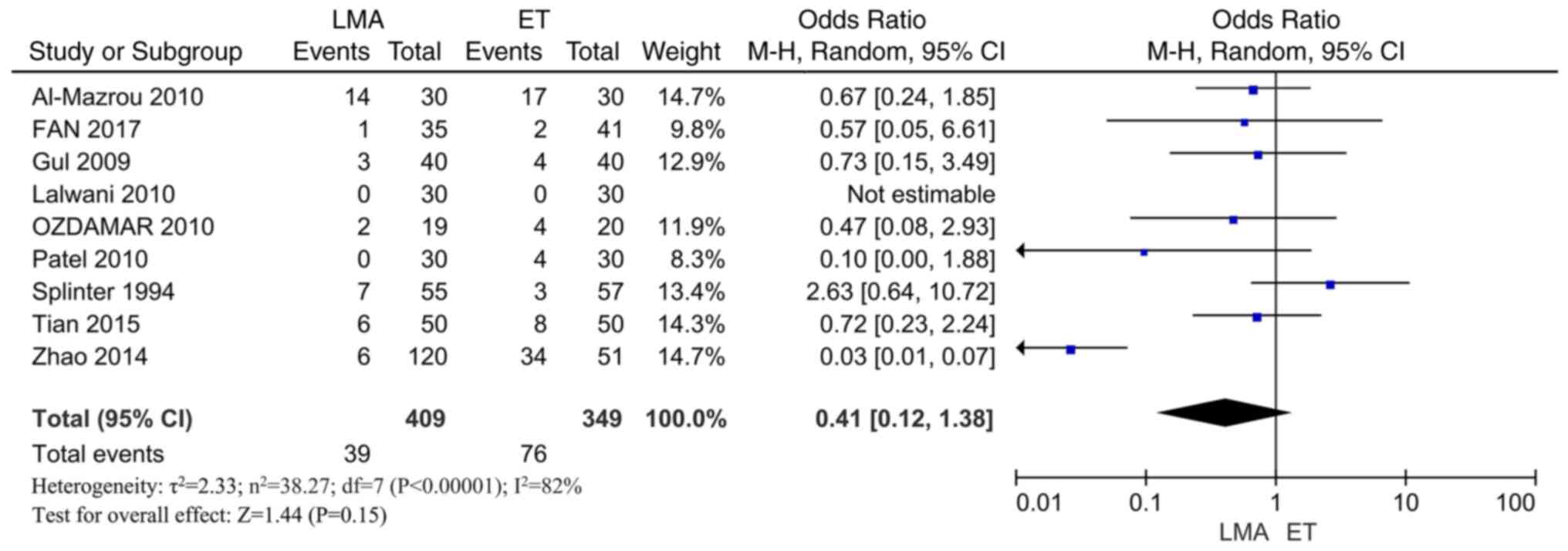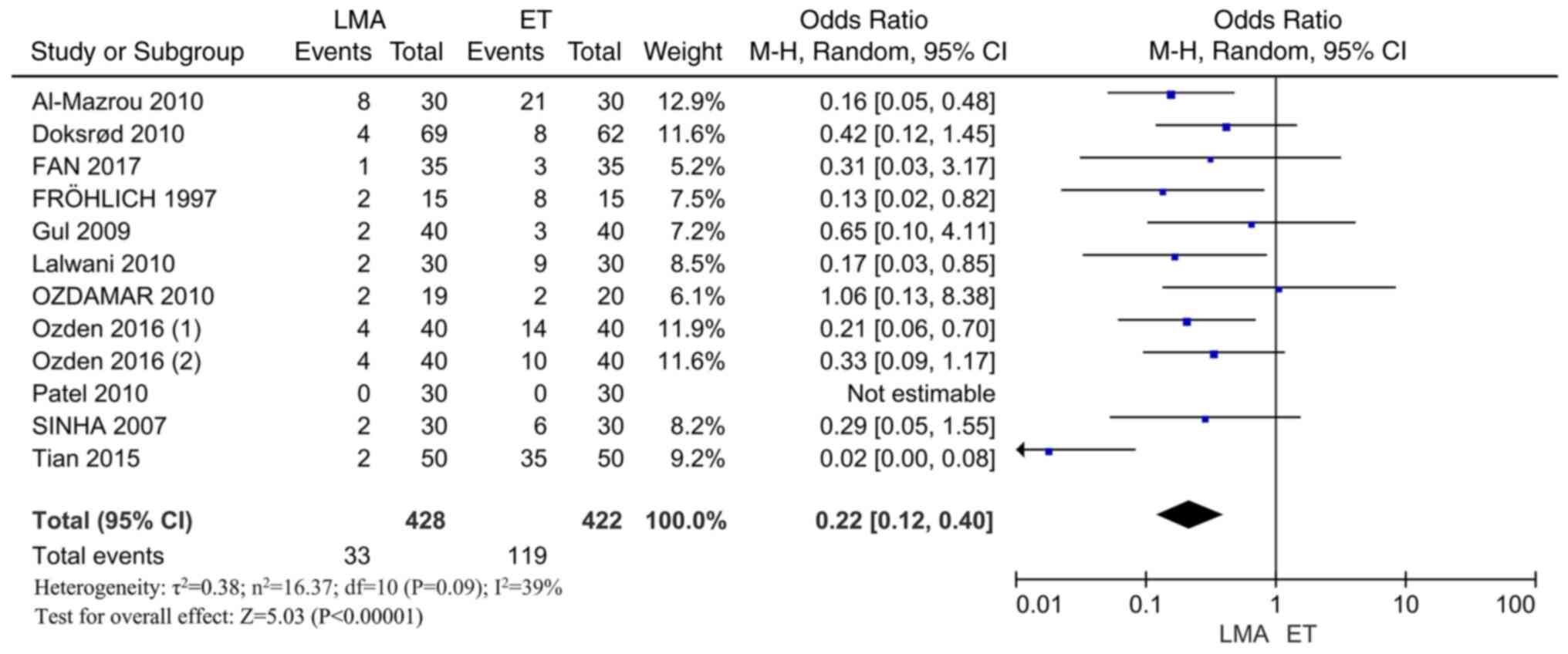|
1
|
Stein ML, Park RS and Kovatsis PG:
Emerging trends, techniques, and equipment for airway management in
pediatric patients. Paediatr Anaesth. 30:269–279. 2020.PubMed/NCBI View Article : Google Scholar
|
|
2
|
Jindal S, Mittal A, Anand LK, Singh M and
Kapoor D: Comparative evaluation of Air-Q blocker and Proseal
laryngeal mask airway in patients undergoing elective surgery under
general anaesthesia: A randomised controlled trial. Indian J
Anaesth. 65 (Suppl 1):S20–S26. 2021.PubMed/NCBI View Article : Google Scholar
|
|
3
|
Martínez-de Los Santos CA and Cruz-Cruz
EF: Laryngeal mask in pediatrics. Rev Esp Anestesiol Reanim (Engl
Ed). 69:315–316. 2022.PubMed/NCBI View Article : Google Scholar
|
|
4
|
Van Zundert AAJ, Gatt SP, Van Zundert
TCRV, Kumar CM and Pandit JJ: Features of new vision-incorporated
third-generation video laryngeal mask airways. J Clin Monit Comput.
36:921–928. 2022.PubMed/NCBI View Article : Google Scholar
|
|
5
|
Nishihara F, Ohkawa M, Hiraoka H, Yuki N
and Saito S: Benefits of the laryngeal mask for airway management
during electroconvulsive therapy. J ECT. 19:211–216.
2003.PubMed/NCBI View Article : Google Scholar
|
|
6
|
Okada Y, Nakayama Y, Hashimoto K, Koike K
and Watanabe N: Ramped versus sniffing position for tracheal
intubation: A systematic review and meta-analysis. Am J Emerg Med.
44:250–256. 2021.PubMed/NCBI View Article : Google Scholar
|
|
7
|
Miller AG, Gentile MA and Coyle JP:
Respiratory therapist endotracheal intubation practices. Respir
Care. 65:954–960. 2020.PubMed/NCBI View Article : Google Scholar
|
|
8
|
Butler K and Winters M: The
physiologically difficult intubation. Emerg Med Clin North Am.
40:615–627. 2022.PubMed/NCBI View Article : Google Scholar
|
|
9
|
Drake-Brockman TF, Ramgolam A, Zhang G,
Hall GL and von Ungern-Sternberg BS: The effect of endotracheal
tubes versus laryngeal mask airways on perioperative respiratory
adverse events in infants: A randomised controlled trial. Lancet.
389:701–708. 2017.PubMed/NCBI View Article : Google Scholar
|
|
10
|
Disma N, Virag K, Riva T, Kaufmann J,
Engelhardt T and Habre W: NECTARINE Group of the European Society
of Anaesthesiology Clinical Trial Network; AUSTRIA (Maria
Vittinghoff); BELGIUM (Francis Veyckemans); CROATIA (Sandra Kralik)
et al. Difficult tracheal intubation in neonates and
infants. NEonate and Children audiT of Anaesthesia pRactice IN
Europe (NECTARINE): A prospective European multicentre
observational study. Br J Anaesth. 126:1173–1181. 2021.PubMed/NCBI View Article : Google Scholar
|
|
11
|
Zhang X, Tan R, Lam WC, Yao L, Wang X,
Cheng CW, Liu F, Chan JC, Aixinjueluo Q, Lau CT, et al: PRISMA
(Preferred Reporting Items for Systematic Reviews and
Meta-Analyses) Extension for Chinese Herbal Medicines 2020
(PRISMA-CHM 2020). Am J Chin Med. 48:1279–1313. 2020.PubMed/NCBI View Article : Google Scholar
|
|
12
|
Hernandez AV, Marti KM and Roman YM:
Meta-Analysis. Chest. 158 (1S):S97–S102. 2020.PubMed/NCBI View Article : Google Scholar
|
|
13
|
Bramer WM, Rethlefsen ML, Kleijnen J and
Franco OH: Optimal database combinations for literature searches in
systematic reviews: A prospective exploratory study. Syst Rev.
6(245)2017.PubMed/NCBI View Article : Google Scholar
|
|
14
|
Higgins JP, Altman DG, Gøtzsche PC, Jüni
P, Moher D, Oxman AD, Savovic J, Schulz KF, Weeks L and Sterne JA:
, et al: The Cochrane Collaboration's tool for assessing
risk of bias in randomised trials. BMJ. 343(d5928)2011.PubMed/NCBI View Article : Google Scholar
|
|
15
|
Martimbianco ALC, Sá KMM, Santos GM,
Santos EM, Pacheco RL and Riera R: Most Cochrane systematic reviews
and protocols did not adhere to the Cochrane's risk of bias 2.0
tool. Rev Assoc Med Bras (1992). 69:469–472. 2023.PubMed/NCBI View Article : Google Scholar
|
|
16
|
Nass M and Noble JH Jr: Whither Cochrane.
Indian J Med Ethics. 4:1–5. 2019.PubMed/NCBI View Article : Google Scholar
|
|
17
|
Riemann D, Baglioni C, Bassetti C,
Bjorvatn B, Dolenc Groselj L, Ellis JG, Espie CA, Garcia-Borreguero
D, Gjerstad M, Gonçalves M, et al: European guideline for the
diagnosis and treatment of insomnia. J Sleep Res. 26:675–700.
2017.PubMed/NCBI View Article : Google Scholar
|
|
18
|
Duman A, Ogün CO and Okesli S: The effect
on intraocular pressure of tracheal intubation or laryngeal mask
insertion during sevoflurane anaesthesia in children without the
use of muscle relaxants. Paediatr Anaesth. 11:421–424.
2001.PubMed/NCBI View Article : Google Scholar
|
|
19
|
Sinha A, Sharma B and Sood J: ProSeal as
an alternative to endotracheal intubation in pediatric laparoscopy.
Paediatr Anaesth. 17:327–332. 2007.PubMed/NCBI View Article : Google Scholar
|
|
20
|
Lalwani J, Dubey KP, Sahu BS and Shah PJ:
ProSeal laryngeal mask airway: An alternative to endotracheal
intubation in paediatric patients for short duration surgical
procedures. Indian J Anaesth. 54:541–545. 2010.PubMed/NCBI View Article : Google Scholar
|
|
21
|
Agrawal G, Agarwal M and Taneja S: A
randomized comparative study of intraocular pressure and
hemodynamic changes on insertion of proseal laryngeal mask airway
and conventional tracheal intubation in pediatric patients. J
Anaesthesiol Clin Pharmacol. 28:326–329. 2012.PubMed/NCBI View Article : Google Scholar
|
|
22
|
Fan CH, Peng B and Zhang FC: Influence of
laryngeal mask airway (LMA) insertion anesthesia on cognitive
function after microsurgery in pediatric neurosurgery. Eur Rev Med
Pharmacol Sci. 21 (4 Suppl):S37–S42. 2017.PubMed/NCBI
|
|
23
|
Gul R, Goksu S, Ugur BK, Sahin L, Koruk S,
Okumus S and Erbagci I: Comparison of proseal laryngeal mask and
endotracheal tube for airway safety in pediatric strabismus
surgery. Saudi Med J. 33:388–394. 2012.PubMed/NCBI
|
|
24
|
Splinter WM, Smallman B, Rhine EJ and
Komocar L: Postoperative sore throat in children and the laryngeal
mask airway. Can J Anaesth. 41:1081–1083. 1994.PubMed/NCBI View Article : Google Scholar
|
|
25
|
Al-Mazrou KA, Abdullah KM, ElGammal MS,
Ansari RA, Turkistani A and Abdelmeguid ME: Laryngeal mask airway
vs. uncuffed endotracheal tube for nasal and paranasal sinus
surgery: Paediatric airway protection. Eur J Anaesthesiol.
27:16–19. 2010.PubMed/NCBI View Article : Google Scholar
|
|
26
|
Ozdamar D, Güvenç BH, Toker K, Solak M and
Ekingen G: Comparison of the effect of LMA and ETT on ventilation
and intragastric pressure in pediatric laparoscopic procedures.
Minerva Anestesiol. 76:592–599. 2010.PubMed/NCBI
|
|
27
|
Patel MG, Swadia V and Bansal G:
Prospective randomized comparative study of use of PLMA and ET tube
for airway management in children under general anaesthesia. Indian
J Anaesth. 54:109–115. 2010.PubMed/NCBI View Article : Google Scholar
|
|
28
|
Tian Y, Wu XY, Li L, Ma L and Li YF: A
clinical trial evaluating the laryngeal mask airway-Supreme in
obese children during general anesthesia. Arch Med Sci. 13:183–190.
2017.PubMed/NCBI View Article : Google Scholar
|
|
29
|
Ozden ES, Meco BC, Alanoglu Z and Alkıs N:
Comparison of ProSeal laryngeal mask airway (PLMA) with cuffed and
uncuffed endotracheal tubes in infants. Bosn J Basic Med Sci.
16:286–291. 2016.PubMed/NCBI View Article : Google Scholar
|
|
30
|
Doksrød S, Løfgren B, Nordhammer A,
Svendsen MV, Gisselsson L and Raeder J: Reinforced laryngeal mask
airway compared with endotracheal tube for adenotonsillectomies.
Eur J Anaesthesiol. 27:941–946. 2010.PubMed/NCBI View Article : Google Scholar
|
|
31
|
Peng A, Dodson KM, Thacker LR, Kierce J,
Shapiro J and Baldassari CM: Use of laryngeal mask airway in
pediatric adenotonsillectomy. Arch Otolaryngol Head Neck Surg.
137:42–46. 2011.PubMed/NCBI View Article : Google Scholar
|
|
32
|
Zhao N, Deng F and Yu C: Anesthesia for
pediatric day-case dental surgery: A study comparing the classic
laryngeal mask airway with nasal trachea intubation. J Craniofac
Surg. 25:e245–e248. 2014.PubMed/NCBI View Article : Google Scholar
|
|
33
|
Fröhlich D, Schwall B, Funk W and Hobbhahn
J: Laryngeal mask airway and uncuffed tracheal tubes are equally
effective for low flow or closed system anaesthesia in children. Br
J Anaesth. 79:289–292. 1997.PubMed/NCBI View Article : Google Scholar
|
|
34
|
Chiumello D and Brioni M: Severe
hypoxemia: Which strategy to choose. Crit Care.
20(132)2016.PubMed/NCBI View Article : Google Scholar
|
|
35
|
Kendall MC: Laryngeal mask airway as a
rescue device for failed endotracheal intubation. Eur J Emerg Med.
26(73)2019.PubMed/NCBI View Article : Google Scholar
|
|
36
|
Boroda N, Malesinska M, Kars MS and Smith
LP: The use of laryngeal mask airway for adenoidectomy. Int J
Pediatr Otorhinolaryngol. 107:42–44. 2018.PubMed/NCBI View Article : Google Scholar
|
|
37
|
Zaichkin J, McCarney LD and Rhein M: The
laryngeal mask: Empowering nurses to rescue newborns. Adv Neonatal
Care. 23:140–150. 2023.PubMed/NCBI View Article : Google Scholar
|
|
38
|
van Esch BF, Stegeman I and Smit AL:
Comparison of laryngeal mask airway vs tracheal intubation: A
systematic review on airway complications. J Clin Anesth.
36:142–150. 2017.PubMed/NCBI View Article : Google Scholar
|
|
39
|
Qamarul Hoda M, Samad K and Ullah H:
ProSeal versus Classic laryngeal mask airway (LMA) for positive
pressure ventilation in adults undergoing elective surgery.
Cochrane Database Syst Rev. 7(CD009026)2017.PubMed/NCBI View Article : Google Scholar
|
|
40
|
Ozhan MO, Eskin MB, Atik B, Suzer MA and
Capalar CO: Laryngeal mask airway for general anesthesia in
interventional neuroradiology procedures. Saudi Med J. 40:463–468.
2019.PubMed/NCBI View Article : Google Scholar
|
|
41
|
de Carvalho ALR, Vital RB, de Lira CCS,
Magro IB, Sato PTS, Lima LHN, Braz LG and Módolo NSP: Laryngeal
mask airway versus other airway devices for anesthesia in children
with an upper respiratory tract infection: A systematic review and
meta-analysis of respiratory complications. Anesth Analg.
127:941–950. 2018.PubMed/NCBI View Article : Google Scholar
|
|
42
|
Simon LV and Torp KD: Laryngeal Mask
Airway. StatPearls. Treasure Island, FL, 2022.
|























